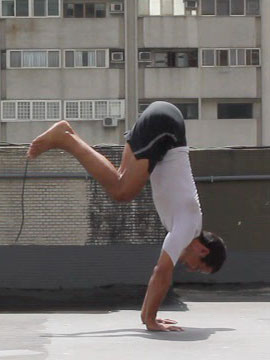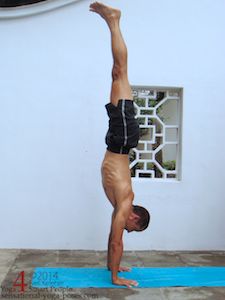Jumping Into Handstand
Tips for jumping into handstand with feet together from downward dog
Balancing in a handstand is relatively simple.
All you have to do is stack your body vertically aligning your shoulder, torso and legs vertically over your hands.
Jumping into handstand with both feet together (as opposed to "scissor kicking") is slightly more difficult.
The first priority is to get your center of gravity over your hands so that you are balanced.
You can practice jumping into "middle position" where your knees are either straight or bent but your feet are at the same height as your hips. Balancing in this position you can then either lift your legs into a full handstand or lower them so that you are in a standing forward fold (like when jumping forward in a sun salutation.)
Balancing in The Middle Position
The advantage of jumping into handstand "middle position" first, apart from having the flexibility of moving up into a full handstand or down into a standing forward bend (or even jumping through) is that it may be eaiser to balance since your center of gravity isn't so far from the ground as it is when your legs are reaching straight up.

Jumping into handstand, shoulders are ahead of the wrists.
However, because your legs are behind your hands (on the side opposite your finger tips) to compensate and balance you'll have to move your chest and pelvis forwards. This is easiest done by moving your shoulders forwards so that your arms are at an angle.
If you knees are straight then you'll have to move your shoulders further forwards. However, if your knees are bent with both your knees and feet close to your body then your shoulders don't have to go quite so far forwards.
Note that in both cases this may be easier to do if you practice stabilizing your shoulders before you jump.
Using Your Hands to Feel Your Center
How do you know when you are balanced whether in the middle position or in actual handstand?
Use your hands as indicators.
Feel your hands when you jump and notice when your body weight is forwards enough to cause your fingers to press into the floor. Use your fingers to hault this forward movement enough so that your weight stays over your hands. Keep your weight slightly forwards so that your fingers continue to press down.
Shorten Your Downward Dog
So that you can get your shoulders ahead of your wrists when jumping into handstand you can practice moving your shoulders ahead of your wrists while still in downward dog.
You may have to shorten your downward dog a little bit. As you move your torso forwards, lift your hips up as high as you can but at the same time try to get your shoulders ahead of your wrists. Then return to downward dog.
Practice this until you get a feel for it. Then try jumping up while in front of a wall.
At first focus on getting your shoulders ahead of your wrists. Don't worry about a full handstand yet. Instead focus on jumping up and either bending your kness and bringing them to your chest, or jumping and straightening your legs and holding your legs and 90 degrees to your body.
You'll need to move your shoulders even more forwards in this case.
Once you can get into the middle position, then work at lifting your legs up into full handstand from. As you move your legs from horizontal to vertical, bring your shoulders back, over your hands, so that you stay balanced.
Observing How the Shoulders and Hands Relate
When jumping into handstand you can use our eyes to see how your shoulders and hands relate.
While jumping you can then see when you get your shoulders where you want them to be, over and then slightly in front of our hands. At the same time you can use your hands to feel when your center of gravity is over your hands by feeling the way your weight presses down through them.
Focus on pulling your hips forwards, so that they are over your shoulers and use your hands to help you feel when your hips and shoulders are balanced by the weight of your legs. Try to balance both on either side of your hands so that your weight presses down through your hands just at the base of your fingers.
Actually Jumping
How do you actually "drive" the jump into handstand? From downward dog lift your heels and bend your knees and sink your pelvis down. Use your legs to drive your pelvis forwards and up. Experiment between focusing on pushing your hips forwards (over your hands or slightly infront of them) and pushing your hips up. When you are jumping focus on using your thighs to drive your feet into the floor. You pelvis will go forwards and up as you do.
There may be a tendency to add to much power, in which case your shoulders and/or pelvis will bump into the wall in front of you.
See if you can gradually increase your leg power. This can be challenging if you are first learning. So get ready to use one foot to kick your back off of the wall.
The feeling, once you drive your feet into the floor is like you are shoving your pelvis forwards. Once your feet leave the floor see if you can leave your knees straight so that you end up in an L-shaped middle position handstand against the wall. If your flexibility is lacking or your haven't yet got the shoulder stability to hold you in this postion then after you straighten your knees, bend them again and leg them come towards your chest into the "bent knee" middle position handstand.
As you get more practice jumping into handstand (or the middle position) then work at using the minimum effort necessary to jump up. Smoothly push your feet into the floor to jump and keep your legs extended. Then as your reach middle position, smoothly lift your legs transfering the momentum from your body up into your legs.
Published: 2011 03 05




